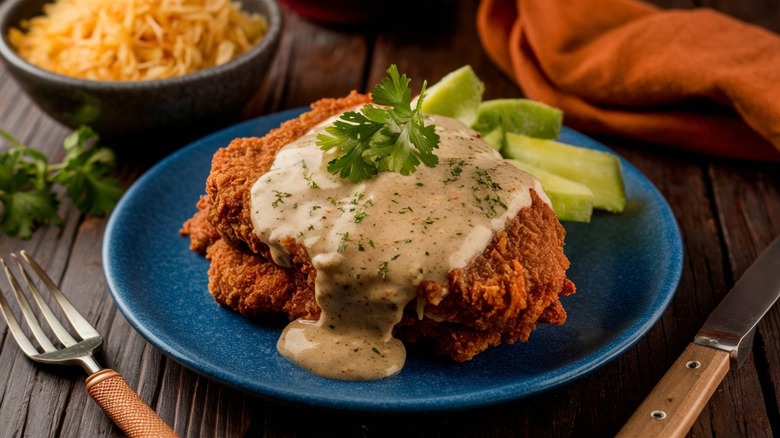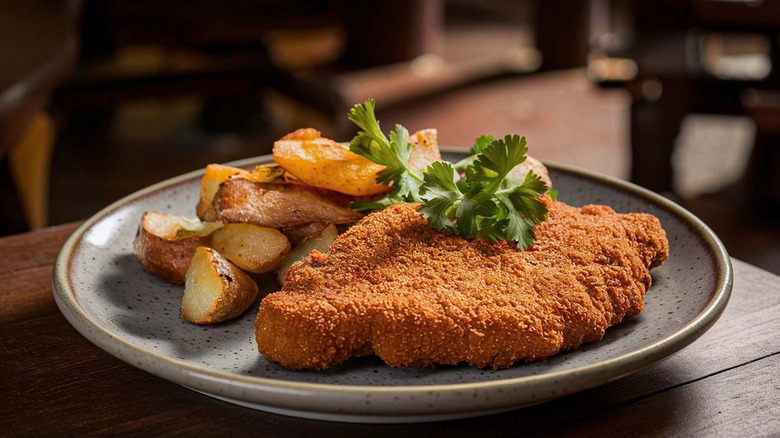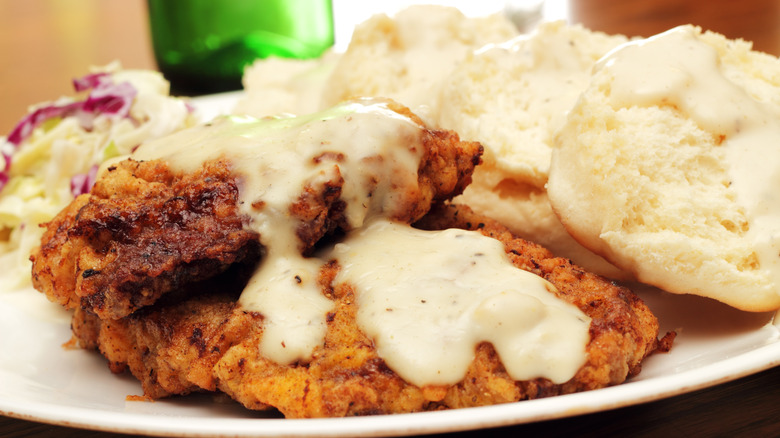Is Schnitzel Essentially Just Chicken-Fried Steak?
When discussing meat dishes, the moment someone learns what a schnitzel is, they usually say, "Okay, so, it's basically a chicken fried steak, right?" The short answer to that question is yes, essentially, Texas' iconic chicken fried steak (a flattened, tough cut of steak cooked fried chicken-style) is schnitzel. But that's not the full answer. Chicken fried steak is probably not exactly the dish a person is talking about if they're using the word "schnitzel" in the first place. To understand why, you have to understand what a schnitzel is. It also helps to understand the distinctions between it and Wienerschnitzel.
A schnitzel is a meat cutlet, usually breaded and fried. The food world abounds with fried cutlets that are, at their essence, schnitzels. Japanese tonkatsu and torikatsu could be defined as schnitzels, for instance. A Wienerschnitzel, however, is a very specific type of schnitzel. (It is not a hot dog, despite the fast food hot dog chain carrying the name.) It is a breaded, fried veal cutlet. In fact, there is a law in place in Austria that requires any food called Wienerschnitzel ("Vienna schnitzel") to be made only of veal — not pork, another common schnitzel meat, or beef, as we find in chicken fried steak.
A reasonable assumption may be that the veal-only Wienerschnitzel descended from the more general schnitzel, but the reverse is actually true: The Wienerschnitzel came first; the wider range of schnitzels are variations on that specific dish. And from those schnitzels came the good ol' chicken fried steak.
Chicken fried steak's origins involve Wienerschnitzel
A number of accounts set the origin of today's schnitzel somewhere in Europe in the late 1800s, with Italian General Joseph Radetzy gushing to Austrian Emperor Franz Joseph I about an incredible veal dish eaten in Lombardy. Franz Joseph's interest was piqued, and Radetzy later ensured the recipe was communicated back to Austria. The Austrians loved it (no big surprise; what's faster, easier, or tastier than fried meat?), and soon after that, the Germans loved it too.
At this point, Germans had been immigrating to Texas since the 1830s in search of political and religious freedom. In addition to their religion and other key cultural features, they brought their food with them. Sometime in the late 1800s, schnitzel started showing up on the kitchen tables of the German diaspora. Love for the dish spread throughout Texas (again, no surprise) and eventually traveled to other states. However, the German Texans of the 1800s weren't eating the exact same dish they made back home; their schnitzel had a Texas twist or two that ultimately turned it into chicken fried steak.
Chicken fried steak evolved from German-Texan schnitzel
The Germans of Texas in the 19th century had to modify their schnitzel based on availability of ingredients. They couldn't make Wienerschnitzel, for instance, because the Texas range at that time wasn't conducive to the raising and selling of veal. Veal calves are raised under very specific conditions that partly involve staying indoors away from the elements. Plus, beef was king in Texas, and the German folk can't be blamed for not going out of their way to procure what would have been a rare and pricey luxury meat that wasn't exactly in demand among the general populace. So, they shifted the meat in their schnitzel almost entirely to the much more cost-effective beef.
Besides the change in protein, the breading of schnitzel also underwent several tweaks over the decades that further facilitated its branch-off into modern chicken fried steak. Keep in mind that chicken fried steak's exact recipe can vary from region to region (Texas has several), but it suffices to say that the coating of traditional schnitzel was simpler than that of today's chicken fried steak – fewer dredges in flour and no milk or buttermilk in the egg wash — making for a crispier and thinner crust. So, while these two dishes come from the same line on the foodie family tree, they have branched off and now stand as distinct culinary creations, each with its own unique character and following.


